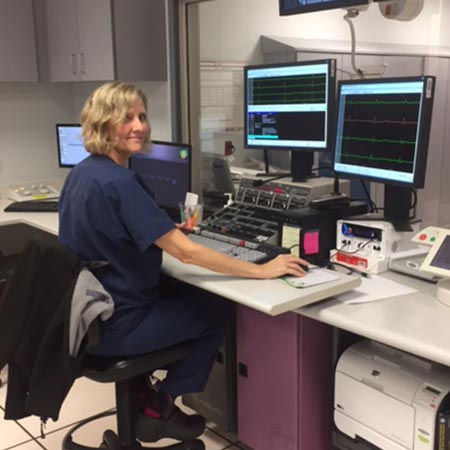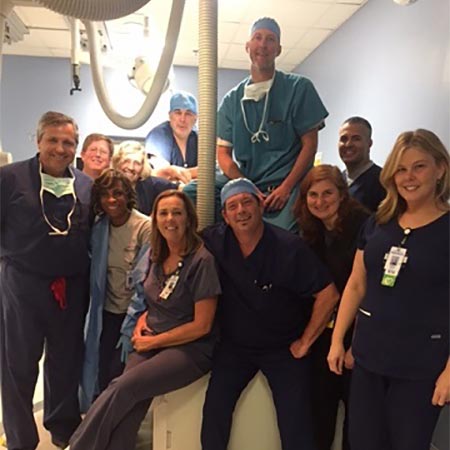
Kelly Kroll, RN
The Electrophysiology Lab (EP Lab) is an amazing part of the hospital, where specially trained electrophysiologists treat heart rhythm problems, known as arrhythmias, and place pacemakers and implantable cardioverter defibrillators.
Kelly Kroll, RN, has been with Parkridge for 17 years and has worked in the EP Lab for two years. She discussed her reasons for joining the EP Lab and why she couldn't be happier that she did.
Where did you start?
“I began my career in the Intensive Care Unit at Parkridge Medical Center. I then transferred to the Emergency Department at Parkridge East Hospital where I worked for five years. After that, I worked in IV Therapy for eight years, placing and maintaining peripherally inserted central catheters – also known as PICCs – midlines, and IVs for both campuses.
“Two years ago, I decided to expand my skills as an RN and transferred to the EP Lab at Parkridge Medical Center. I’ve learned a great deal since joining the department two years ago.”
What were your first impressions of the EP Lab?
“Electrophysiology is intellectually and technically challenging, but Kelly Williams, RN, RCES, the EP Lab manager, has an organized system to ease new nurses into the position. Three nurses work each case: a circulating nurse, a scrub nurse and a monitor nurse – along with the nurse anesthetist, who provides sedation for the patient.
“Each new nurse masters the circulating role before learning the other roles. The circulating nurse meets all patients and reviews their history, identifies allergies, checks medications needed for each case, answers questions the patient and family may have, and transports the patient to the EP Lab.
“Connecting patients to the 3-D mapping system, grounding system, ultrasound system, ablation system, recording system and defibrillator system in the EP Lab takes the entire EP team. The circulator is responsible for ensuring all systems are connected and functioning properly. We do a lot of trouble shooting pretty much every day.
“During the procedure, the circulating nurse ensures the electrophysiologist and the certified registered nurse anesthetists have whatever they need.
“Following the procedure, the circulating nurse takes the patient to the Cardiac Recovery Unit.”

The Electrophysiology Lab staff
What do you like about working in the EP Lab?
“The teamwork is amazing. Everybody helps each other. The team is relatively small, and we all work really well together. We also have a great working relationship with the electrophysiologists (Christian Allan, MD; Timothy Talbert, MD; and Brian Cooper, MD), who enjoy sharing their knowledge with us in the lab.”
What are the biggest challenges?
“Arrhythmias can be hard to locate. Typical cases last between 45 and 90 minutes, but if the cause of the arrhythmia is elusive, or the electrophysiologist identifies a second point of origin for an arrhythmia, cases may take longer.
“This can be tiring at times, as we are on our feet quite a bit while wearing heavy lead aprons to protect against radiation from our imaging equipment. Fortunately, nurses change roles throughout the day, which helps prevent fatigue. For example, I may be the scrub nurse on one case, the monitor nurse sitting at a computer control panel for the next case and the circulating nurse on the third case.”
What are big wins?
“EP procedures to treat arrhythmias require ablation, which is a method that harnesses one of several types of energy to safely burn heart tissue until the heart rhythm normalizes. There is a monitor in the control room that shows the patient’s rhythm at all times, and you can see the irregularity that indicates an arrhythmia. In some instances, the electrophysiologist will ablate an area and the heart will instantly go into sinus rhythm [the heart’s normal rhythm]. We call that a ‘BAM’ moment.
“These moments happen quickly and are very exciting.”
Have you been involved in any of the innovative procedures recently performed in the Parkridge EP Lab?
“Yes, the WATCHMAN Left Atrial Appendage Device has been a very exciting new treatment. Our electrophysiologists quickly mastered the procedure. The WATCHMAN is an amazing device. It looks like a jellyfish or an umbrella and can help prevent strokes in patients with atrial fibrillation (AFib) who can’t tolerate blood-thinning medication, which is the traditional means for stroke prevention in such patients. I am really excited to be a part of this amazing, potentially life-saving procedure.
“I’ve also been involved with the Convergent Procedure, which is a fairly new approach to treating persistent AFib. We collaborate with cardiothoracic surgeons, who perform the first part of the procedure and then transfer the patient to us. There’s a flurry of activity when the patient comes from surgery, but once they’re in the EP Lab, it’s business as usual.”
What would you want someone who doesn’t know anything about the EP Lab to know?
“It’s challenging to learn but very rewarding. I can’t stress the teamwork aspect enough. Everybody works really well together and helps each other. To that point: I’m the newest member of the EP Lab team, and I’ve been there for two years. The next-newest member of the team has been there for eight years. That says a lot.”
More about Kelly
Where did you go to nursing school?
- “The University of Tennessee at Knoxville”
What do you do for fun?
- “Hiking, running and being a mom to two amazing teenagers. I also love to travel.”
Where have your travels taken you?
- “Before I became a nurse, I made it my goal to see as much of the world as I could. During this time, I lived in Australia for almost a year and in England for six months. I also taught English while living in Thailand for nine months. I’ve traveled around the world a total of three times and still have ‘itchy feet.’”
Where to next?
- “When the kids are older, I’d love to travel to Africa and South America and will definitely return to Australia, New Zealand and Greece.”
$webqFacilityNumber
Need a Physician?